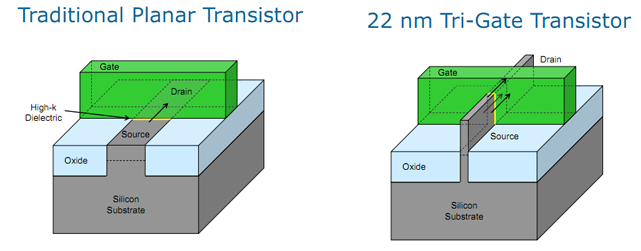Intel Announces 22nm Ivy Bridge CPUs with New '3D' Transistors

Today, Intel announced that it has developed a new generation of 22nm CPUs which use a revolutionary "3D" transistor design to achieve new levels of performance and power efficiency. By using a three-dimensional silicon fin that rises vertically from the silicon substrate, the new 3D Tri-Gate transistors boast a 37-percent increase in speed while using less than half the power of a traditional "2D" planar transistor on current 32nm Intel chips.
In its press release, Intel touts its Tri-Gate transistors as a "reinvention of the transistor." By placing gates on three sides of the vertical fin on each transistor (as opposed to just one gate on traditional transistors), Intel allows more current to flow when those transistors are in the active or "on" state and even less to flow when it's inactive. The vertical fin designs allows the transistors to be packed more tightly onto the chip die, which is important when you're packing a billion of them onto a single chip. Smaller and more tightly packed transistors lead to more power-efficient chips.
Codenamed "Ivy Bridge," the new CPUs should go into production in the second half of 2011. After rolling off Intel's assembly line, these chips should find their way into products ranging from notebooks to servers and mobile devices. The company also plans 14nm chips for 2013 and 10nm processors for 2015.
Check out Intel's videos below to get a better idea of how the new 3D Tri-Gate Transistors Work.
Stay in the know with Laptop Mag
Get our in-depth reviews, helpful tips, great deals, and the biggest news stories delivered to your inbox.

